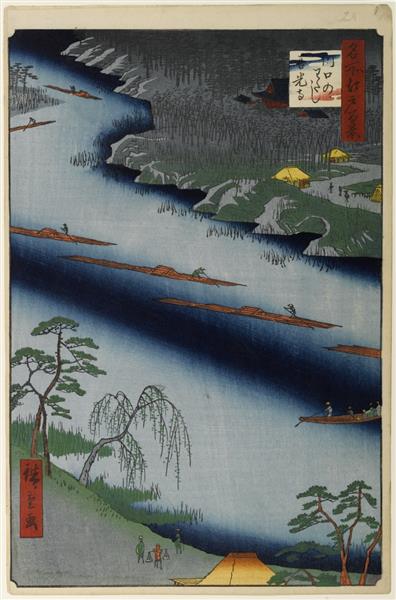Descrição
In his 1857 work “The Kawaguchi Ferry and Zenkōji Temple,” Utagawa Hiroshige captures an essential scene in the Japanese landscape that reflects both the natural beauty and rich spiritual culture of his time. This woodblock print, part of the “Fifty-Three Stations of the Tōkaidō” series, becomes a visual experience that evokes the coexistence between man and nature, as well as immersion in Japanese spirituality.
The composition of the work is elegantly balanced. In the foreground, a ferry is sailing along the river, loaded with travelers heading toward the celebrated Zenkōji Temple, a major Buddhist pilgrimage destination in Nagano. The characters, though small in scale, are arranged in such a way as to lend a dynamic narrative to the scene. Several travelers can be glimpsed on the ferry, each displaying a style of dress that suggests the social diversity of those times; the use of parasols and traditional clothing not only adds color to the scene, but also illustrates the everyday culture of 19th-century Japan.
The colors used by Hiroshige are subtle, contributing to the ethereal atmosphere of the work. Soft shades of blue, green and gray predominate, evoking the serenity of the natural landscape, contrasting with the more vibrant touches of the characters’ clothing. The use of color in “The Kawaguchi Ferry and Zenkōji Temple” is characteristic of the ukiyo-e style in which Hiroshige excels, where attention to light and atmosphere become transversal elements that serve as guiding threads in the visual narrative.
The background of the work is equally fascinating. As one ascends into the composition, one can see the majestic, almost ethereal mountains that frame the landscape, suggesting a deep connection between the spiritual world and the natural world. These mountains, which are typical of the Japanese environment, not only serve as a backdrop, but also symbolize the path that the pilgrim must follow on his spiritual journey to the temple. The presence of the Zenkōji Temple is hinted at on the horizon, creating an expectation that is combined with the element of movement of the ferry in the foreground.
A master of ukiyo-e, Hiroshige has left an indelible mark on the history of Japanese art. His ability to capture ephemeral moments of everyday life and nature is manifested through a printing technique that has been admired and emulated around the world. Influences from Edo period landscape painting, as well as colour and composition systems, are prominent in this work, making it a paradigmatic example of his style. Often compared to contemporaries such as Katsushika Hokusai, Hiroshige is distinguished by his more lyrical and contemplative approach, inviting the viewer to experience the emotional depth of the scene.
In this sense, “Kawaguchi Ferry and Zenkōji Temple” is not only a visual representation, but also a meditation on the human spiritual journey, the symbiotic relationship with nature, and the search for divinity. Through his meticulous composition, soft palette, and evocative narrative, Hiroshige offers us a respite from modernity and a reminder of the rich cultural traditions that continue to nourish the soul of Japan. The work remains a testament to a moment in time, as well as a beacon guiding future artists and art lovers to explore the interrelationships between landscape, culture, and spirituality.
KUADROS ©, a famous painting on your wall.
Hand-made oil painting reproductions, with the quality of professional artists and the distinctive seal of KUADROS ©.
Painting reproduction service with satisfaction guarantee. If you are not completely satisfied with the replica of your painting, we will refund 100% of your money.

